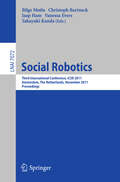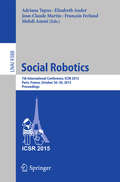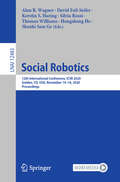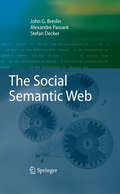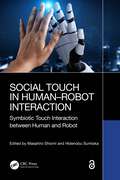- Table View
- List View
Social Robotics: 13th International Conference, ICSR 2021, Singapore, Singapore, November 10–13, 2021, Proceedings (Lecture Notes in Computer Science #13086)
by Haizhou Li Shuzhi Sam Ge Yan Wu Agnieszka Wykowska Hongsheng He Xiaorui Liu Dongyu Li Jairo Perez-OsorioThis book constitutes the refereed proceedings of the 13th International Conference on Social Robotics, ICSR 2021, held in Singapore, Singapore, in November 2021. The conference was held as a hybrid event.The 64 full papers and 15 short papers presented were carefully reviewed and selected from 114 submissions. The conference presents topics on humans and intelligent robots and on the integration of robots into the fabric of our society. The theme of the 2021 edition was “Robotics in our everyday lives”, emphasizing on the increasing importance of robotics in human daily living.
Social Robotics: Third International Conference on Social Robotics, ICSR 2011, Amsterdam, The Netherlands, November 24-25, 2011. Proceedings (Lecture Notes in Computer Science #7072)
by Bilge Mutlu Christoph Bartneck Jaap Ham Vanessa Evers Takayuki KandaThis book constitutes the refereed proceedings of the Third International Conference on Social Robotics, ICSR 2011, held in Amsterdam, The Netherlands, in November 2011. The 23 revised full papers were carefully selected during two rounds of reviewing and improvement from 51 submissions. The papers are organized in topical sections on social interaction with robots; nonverbal interaction with social robots; robots in society; social robots in education; affective interaction with social robots; robots in the home.
Social Robotics: 7th International Conference, ICSR 2015, Paris, France, October 26-30, 2015, Proceedings (Lecture Notes in Computer Science #9388)
by Adriana Tapus Elisabeth André Jean-Claude Martin François Ferland Mehdi AmmiThis book constitutes the refereed proceedings of the 7th International Conference on Social Robotics, ICSR 2015, held in Paris, France, in October 2015. The 70 revised full papers presented were carefully reviewed and selected from 126 submissions. The papers focus on the interaction between humans and robots and the integration of robots into our society and present innovative ideas and concepts, new discoveries and improvements, novel applications on the latest fundamental advances in the core technologies that form the backbone of social robotics, distinguished developmental projects, as well as seminal works in aesthetic design, ethics and philosophy, studies on social impact and influence pertaining to social robotics, and its interaction and communication with human beings and its social impact on our society.
Social Robotics: 12th International Conference, ICSR 2020, Golden, CO, USA, November 14–18, 2020, Proceedings (Lecture Notes in Computer Science #12483)
by Alan R. Wagner David Feil-Seifer Kerstin S. Haring Silvia Rossi Thomas Williams Hongsheng He Shuzhi Sam GeThis book constitutes the refereed proceedings of the 12th International Conference on Social Robotics, ICSR 2020, held in Golden, CO, USA, in November 2020. The conference was held virtually.The 57 full papers presented were carefully reviewed and selected from 101 submissions. The theme of the 2020 conference is Entertaining Robots. The papers focus on the following topics: human-robot trust and human-robot teaming, robot understanding and following of social and moral norms, physical and interaction design of social robots, verbal and nonverbal robot communication, interactive robot learning, robot motion and proxemics, and robots in domains such as education and healthcare.
Social Robots: Technological, Societal And Ethical Aspects Of Human-robot Interaction (Human–Computer Interaction Series)
by Oliver KornSocial robots not only work with humans in collaborative workspaces – we meet them in shopping malls and even more personal settings like health and care. Does this imply they should become more human, able to interpret and adequately respond to human emotions? Do we want them to help elderly people? Do we want them to support us when we are old ourselves? Do we want them to just clean and keep things orderly – or would we accept them helping us to go to the toilet, or even feed us if we suffer from Parkinson’s disease? The answers to these questions differ from person to person. They depend on cultural background, personal experiences – but probably most of all on the robot in question. This book covers the phenomenon of social robots from the historic roots to today’s best practices and future perspectives. To achieve this, we used a hands-on, interdisciplinary approach, incorporating findings from computer scientists, engineers, designers, psychologists, doctors, nurses, historians and many more. The book also covers a vast spectrum of applications, from collaborative industrial work over education to sales. Especially for developments with a high societal impact like robots in health and care settings, the authors discuss not only technology, design and usage but also ethical aspects. Thus this book creates both a compendium and a guideline, helping to navigate the design space for future developments in social robotics.
Social Robots from a Human Perspective
by Jane Vincent Sakari Taipale Bartolomeo Sapio Giuseppe Lugano Leopoldina FortunatiThis book presents a comprehensive overview of the human dimension of social robots by discussing both transnational features and national peculiarities. Addressing several issues that explore the human side of social robots, this book investigates what a social robot is and how we might come to think about social robots in the different areas of everyday life. Organized around three sections that deal with Perceptions and Attitudes to Social Robots, Human Interaction with Social Robots, and Social Robots in Everyday Life, it explores the idea that even if the challenges of robot technologies can be overcome from a technological perspective, the question remains as to what kind of machine we want to have and use in our daily lives.Lessons learned from previous widely adopted technologies, such as smartphones, indicate that robot technologies could potentially be absorbed into the everyday lives of humans in such a way that it is the human that determines the human-machine interaction. In a similar way to how today’s information and communication technologies were initially designed for professional/industrial use, but were soon commercialized for the mass market and then personalized by humans in the course of daily practice, the use of social robots is now facing the same revolution of ‘domestication.’ In the context of this transformation, which involves the profound embedding of robots in everyday life, the ‘human’ aspect of social robots will play a major part. This book sheds new light on this highly topical issue, one of the central subjects that will be taught and studied at universities worldwide and that will be discussed widely, publicly and repeatedly in the near future.
Social Science Microsimulation
by Klaus G. Troitzsch Ulrich Mueller Nigel Gilbert Jim E. DoranThis book gives an overview of the state of the art in five different approaches to social science simulation on the individual level. The volume contains microanalytical simulation models designed for policy implementation and evaluation, multilevel simulation methods designed for detecting emergent phenomena, dynamical game theory applications, the use of cellular automata to explain the emergence of structure in social systems, and multi-agent models using the experience from distributed artificial intelligence applied to special phenomena. The book collects the results of an international conference which brought together social scientists and computer scientists both engaged in a wide range of simulation approaches for the first time.
Social Science Research on CAD/CAM: Results of a First European Workshop
by Michael Rader Bernd Wingert Ulrich RiehmComputer Aided Design (CAD) and Computer Aided Manufacture (CAM) are but two of the more recent examples of computer applications in domains previously dominated by human labour. The use of computers in such areas has increasingly attracted social science research. There are several reasons one could suggest for this, not least of them being the simple fact that public money is being provided for such research. Of course, some of the interest may be due to the wish to prove that technology is being used to inhuman ends, but undoubtedly there is also some degree of fascination involved. Can you really do all the things with computers that people claim you can? There is certainly satisfaction to be had from smugly pointing out its shortcomings, but many of the few sociologists in our own organisation are also among the most avid users of modern technology. Needless to say, they also belong to the most critical users of the technology! A new strain of motivation for social science research which appears to be gaining significance, is the desire to "re-direct" technology, or at least - and probably more realistically - to playa part in shaping future technology . The entire range of motives may be recognised in the collection of papers contained in this volume.
Social Selling: Techniques to Influence Buyers and Changemakers
by Timothy HughesUnderstand how to reach and engage with the modern buyer using this bestseller. Social Selling outlines how to implement a social selling strategy and drive revenue, competitive advantage and market share through social networks.Social Selling is a practical, step-by-step blueprint on how to create digital communities and build and turn relationships into sales online. Featuring checklists, tips and examples providing practical guidance, it covers important subjects such as how to network purposely and build social media trust in a mistrustful time and how to develop real influence and authority in your subject area.Now newly revised, the second edition of Social Selling captures the latest changes and developments in the industry. It will be accompanied by a new introductory chapter, two new chapters on defining digital businesses and the future of sales and marketing, alongside new case studies by leading industry experts. Written by a thought-leader and renowned practitioner in social selling, Timothy Hughes, this book is essential reading for sales professionals, digital sales directors and social media executives who want to embrace the power of social selling in their organization.
Social Semantic Web: Web 2.0 - Was nun? (X.media.press)
by Andreas Blumauer Tassilo PellegriniSemantische Techniken zur strukturierten Erschließung von Web 2.0-Content und kollaborative Anreicherung von Web Content mit maschinenlesbaren Metadaten wachsen zum Social Semantic Web zusammen. Kennzeichnend ist dabei die breite Konvergenz zwischen Social Software und Semantic Web-Technologien. Das Buch stellt die technischen, organisatorischen und kulturellen Veränderungen dar, die das Social Semantic Web begleiten. Entscheidungsträger und Entwickler können auf dieser Grundlage die Tragweite dieser Technologie für ihr Unternehmen erkennen.
The Social Semantic Web
by John G Breslin Alexandre Passant Stefan DeckerThe Social Web (including services such as MySpace, Flickr, last.fm, and WordPress) has captured the attention of millions of users as well as billions of dollars in investment and acquisition. Social websites, evolving around the connections between people and their objects of interest, are encountering boundaries in the areas of information integration, dissemination, reuse, portability, searchability, automation and demanding tasks like querying. The Semantic Web is an ideal platform for interlinking and performing operations on diverse person- and object-related data available from the Social Web, and has produced a variety of approaches to overcome the boundaries being experienced in Social Web application areas. After a short overview of both the Social Web and the Semantic Web, Breslin et al. describe some popular social media and social networking applications, list their strengths and limitations, and describe some applications of Semantic Web technology to address their current shortcomings by enhancing them with semantics. Across these social websites, they demonstrate a twofold approach for interconnecting the islands that are social websites with semantic technologies, and for powering semantic applications with rich community-created content. They conclude with observations on how the application of Semantic Web technologies to the Social Web is leading towards the "Social Semantic Web" (sometimes also called "Web 3.0"), forming a network of interlinked and semantically-rich content and knowledge. The book is intended for computer science professionals, researchers, and graduates interested in understanding the technologies and research issues involved in applying Semantic Web technologies to social software. Practitioners and developers interested in applications such as blogs, social networks or wikis will also learn about methods for increasing the levels of automation in these forms of Web communication.
Social Semantic Web Mining (Synthesis Lectures on Data, Semantics, and Knowledge)
by Tope Omitola Sebastián Ríos John BreslinThe past ten years have seen a rapid growth in the numbers of people signing up to use Web-based social networks (hundreds of millions of new members are now joining the main services each year) with a large amount of content being shared on these networks (tens of billions of content items are shared each month). With this growth in usage and data being generated, there are many opportunities to discover the knowledge that is often inherent but somewhat hidden in these networks. Web mining techniques are being used to derive this hidden knowledge. In addition, the Semantic Web, including the Linked Data initiative to connect previously disconnected datasets, is making it possible to connect data from across various social spaces through common representations and agreed upon terms for people, content items, etc. In this book, we detail some current research being carried out to semantically represent the implicit and explicit structures on the Social Web, along with the techniques being used to elicit relevant knowledge from these structures, and we present the mechanisms that can be used to intelligently mesh these semantic representations with intelligent knowledge discovery processes. We begin this book with an overview of the origins of the Web, and then show how web intelligence can be derived from a combination of web and Social Web mining. We give an overview of the Social and Semantic Webs, followed by a description of the combined Social Semantic Web (along with some of the possibilities it affords), and the various semantic representation formats for the data created in social networks and on social media sites. Provenance and provenance mining is an important aspect here, especially when data is combined from multiple services. We will expand on the subject of provenance and especially its importance in relation to social data. We will describe extensions to social semantic vocabularies specifically designed for community mining purposes (SIOCM). In the last three chapters, we describe how the combination of web intelligence and social semantic data can be used to derive knowledge from the Social Web, starting at the community level (macro), and then moving through group mining (meso) to user profile mining (micro).
Social Semantics: The Search for Meaning on the Web (Semantic Web and Beyond #13)
by Harry HalpinSocial Semantics: The Search for Meaning on the Web provides a unique introduction to identity and reference theories of the World Wide Web, through the academic lens of philosophy of language and data-driven statistical models. The Semantic Web is a natural evolution of the Web, and this book covers the URL-based Web architecture and Semantic Web in detail. It has a robust empirical side which has an impact on industry. Social Semantics: The Search for Meaning on the Web discusses how the largest problem facing the Semantic Web is the problem of identity and reference, and how these are the results of a larger general theory of meaning. This book hypothesizes that statistical semantics can solve these problems, illustrated by case studies ranging from a pioneering study of tagging systems to using the Semantic Web to boost the results of commercial search engines. Social Semantics: The Search for Meaning on the Web targets practitioners working in the related fields of the semantic web, search engines, information retrieval, philosophers of language and more. Advanced-level students and researchers focusing on computer science will also find this book valuable as a secondary text or reference book.
Social Sensing: Building Reliable Systems on Unreliable Data
by Dong Wang Tarek Abdelzaher Lance KaplanIncreasingly, human beings are sensors engaging directly with the mobile Internet. Individuals can now share real-time experiences at an unprecedented scale. Social Sensing: Building Reliable Systems on Unreliable Data looks at recent advances in the emerging field of social sensing, emphasizing the key problem faced by application designers: how to extract reliable information from data collected from largely unknown and possibly unreliable sources. The book explains how a myriad of societal applications can be derived from this massive amount of data collected and shared by average individuals. The title offers theoretical foundations to support emerging data-driven cyber-physical applications and touches on key issues such as privacy. The authors present solutions based on recent research and novel ideas that leverage techniques from cyber-physical systems, sensor networks, machine learning, data mining, and information fusion. - Offers a unique interdisciplinary perspective bridging social networks, big data, cyber-physical systems, and reliability - Presents novel theoretical foundations for assured social sensing and modeling humans as sensors - Includes case studies and application examples based on real data sets - Supplemental material includes sample datasets and fact-finding software that implements the main algorithms described in the book
Social Simulation for a Crisis: Results and Lessons from Simulating the COVID-19 Crisis (Computational Social Sciences)
by Frank DignumSimulating for a crisis is far more than creating a simulation of a crisis situation. In order for a simulation to be useful during a crisis, it should be created within the space of a few days to allow decision makers to use it as quickly as possible. Furthermore, during a crisis the aim is not to optimize just one factor, but to balance various, interdependent aspects of life. In the COVID-19 crisis, decisions had to be made concerning e.g. whether to close schools and restaurants, and the (economic) consequences of a 3 or 4-week lock-down had to be considered. As such, rather than one simulation focusing on a very limited aspect, a framework allowing the simulation of several different scenarios focusing on different aspects of the crisis was required. Moreover, the results of the simulations needed to be easily understandable and explainable: if a simulation indicates that closing schools has no effect, this can only be used if the decision makers can explain why this is the case. This book describes how a simulation framework was created for the COVID-19 crisis, and demonstrates how it was used to simulate a wide range of scenarios that were relevant for decision makers at the time. It also discusses the usefulness of the approach, and explains the decisions that had to be made along the way as well as the trade-offs. Lastly, the book examines the lessons learned and the directions for the further development of social simulation frameworks to make them better suited to crisis situations, and to foster a more resilient society.
Social Simulation for a Digital Society: Applications and Innovations in Computational Social Science (Springer Proceedings in Complexity)
by Diane Payne Johan A. Elkink Nial Friel Thomas U. Grund Tamara Hochstrasser Pablo Lucas Adrian Ottewill“Social Simulation for a Digital Society” provides a cross-section of state-of-the-art research in social simulation and computational social science. With the availability of big data and faster computing power, the social sciences are undergoing a tremendous transformation. Research in computational social sciences has received considerable attention in the last few years, with advances in a wide range of methodologies and applications. Areas of application of computational methods range from the study of opinion and information dynamics in social networks, the formal modeling of resource use, the study of social conflict and cooperation to the development of cognitive models for social simulation and many more. This volume is based on the Social Simulation Conference of 2017 in Dublin and includes applications from across the social sciences, providing the reader with a demonstration of the highly versatile research in social simulation, with a particular focus on public policy relevance in a digital society. Chapters in the book include contributions to the methodology of simulation-based research, theoretical and philosophical considerations, as well as applied work. This book will appeal to students and researchers in the field.
Social Software Engineering: Development and Collaboration with Social Networking
by Jessica KeyesAlthough the precepts of software engineering have been around for decades, the field has failed to keep pace with rapid advancements in computer hardware and software. Modern systems that integrate multiple platforms and architectures, along with the collaborative nature of users who expect an instantaneous global reach via the Internet, require u
Social Software Engineering: Development and Collaboration with Social Networking
by Jessica KeyesAlthough the precepts of software engineering have been around for decades, the field has failed to keep pace with rapid advancements in computer hardware and software. Modern systems that integrate multiple platforms and architectures, along with the collaborative nature of users who expect an instantaneous global reach via the Internet, require u
Social Software Engineering: Development and Collaboration with Social Networking
by Jessica KeyesAlthough the precepts of software engineering have been around for decades, the field has failed to keep pace with rapid advancements in computer hardware and software. Modern systems that integrate multiple platforms and architectures, along with the collaborative nature of users who expect an instantaneous global reach via the Internet, require u
A Social Strategy: How We Profit from Social Media
by Mikolaj Jan PiskorskiAlmost no one had heard of social media a decade ago, but today websites such as Facebook, Twitter, and LinkedIn have more than 1 billion users and account for almost 25 percent of Internet use. Practically overnight, social media seems indispensable to our lives--from friendship and dating to news and business.What makes social media so different from traditional media? Answering that question is the key to making social media work for any business, argues Miko?aj Piskorski, one of the world's leading experts on the business of social media. In A Social Strategy, he provides the most convincing answer yet, one backed by original research, data, and case studies from companies such as Nike and American Express.Drawing on his analysis of proprietary data from social media sites, Piskorski argues that the secret of successful ones is that they allow people to fulfill social needs that either can’t be met offline or can be met only at much greater cost. This insight provides the key to how companies can leverage social platforms to create a sustainable competitive advantage. Companies need to help people interact with each other before they will promote products to their friends or help companies in other ways. Done right, a company’s social media should benefit customers and the firm. Piskorski calls this "a social strategy," and he describes how companies such as Yelp and Zynga have done it.Groundbreaking and important, A Social Strategy provides not only a story- and data-driven explanation for the explosion of social media but also an invaluable, concrete road map for any company that wants to tap the marketing potential of this remarkable phenomenon.
A Social Strategy: How We Profit from Social Media (PDF)
by Mikolaj Jan PiskorskiAlmost no one had heard of social media a decade ago, but today websites such as Facebook, Twitter, and LinkedIn have more than 1 billion users and account for almost 25 percent of Internet use. Practically overnight, social media seems indispensable to our lives--from friendship and dating to news and business.What makes social media so different from traditional media? Answering that question is the key to making social media work for any business, argues Miko?aj Piskorski, one of the world's leading experts on the business of social media. In A Social Strategy, he provides the most convincing answer yet, one backed by original research, data, and case studies from companies such as Nike and American Express.Drawing on his analysis of proprietary data from social media sites, Piskorski argues that the secret of successful ones is that they allow people to fulfill social needs that either can’t be met offline or can be met only at much greater cost. This insight provides the key to how companies can leverage social platforms to create a sustainable competitive advantage. Companies need to help people interact with each other before they will promote products to their friends or help companies in other ways. Done right, a company’s social media should benefit customers and the firm. Piskorski calls this "a social strategy," and he describes how companies such as Yelp and Zynga have done it.Groundbreaking and important, A Social Strategy provides not only a story- and data-driven explanation for the explosion of social media but also an invaluable, concrete road map for any company that wants to tap the marketing potential of this remarkable phenomenon.
Social Touch in Human–Robot Interaction: Symbiotic touch interaction between human and robot
by Masahiro Shiomi Hidenobu SumiokaIn this book for researchers and students, editors Shiomi and Sumioka bring together contributions from researchers working on the CREST project at ATR Deep Interaction Laboratories, a world leader in social robotics, to comprehensively describe robot touch systems from hardware to applications.Appropriate touch from robots to humans is essential for social robots, but achieving this requires various solutions at every stage of the touch process. Through this book, readers will gain an understanding of the needs, essential systems and communication cues, behaviour designs, and real‑world issues for social touch applications. This book compiles and updates technical and empirical research that was previously scattered throughout the literature into a single volume. Through individually authored chapters addressing various elements of ATR’s CREST project, this book tackles key areas where understanding is needed to realize acceptable touch interaction, including pre‑touch interaction, interaction design for touching and being touched, behaviour changes caused by touch interaction, and applications of social touch interaction. It introduces a touch sensor and robots developed by the authors, including several touch‑related behaviours and design policies. This approach will enable readers to easily apply this knowledge to their own social robotics programs. This book is invaluable for anyone who wishes to understand and develop social robots that physically interact with people.It is most beneficial for researchers and upper undergraduate and graduate students in the fields of human–robot/agent/computer interaction and social touch interaction and those in the broader fields of engineering, computer science, and cognitive science.
Social Touch in Human–Robot Interaction: Symbiotic touch interaction between human and robot
In this book for researchers and students, editors Shiomi and Sumioka bring together contributions from researchers working on the CREST project at ATR Deep Interaction Laboratories, a world leader in social robotics, to comprehensively describe robot touch systems from hardware to applications.Appropriate touch from robots to humans is essential for social robots, but achieving this requires various solutions at every stage of the touch process. Through this book, readers will gain an understanding of the needs, essential systems and communication cues, behaviour designs, and real‑world issues for social touch applications. This book compiles and updates technical and empirical research that was previously scattered throughout the literature into a single volume. Through individually authored chapters addressing various elements of ATR’s CREST project, this book tackles key areas where understanding is needed to realize acceptable touch interaction, including pre‑touch interaction, interaction design for touching and being touched, behaviour changes caused by touch interaction, and applications of social touch interaction. It introduces a touch sensor and robots developed by the authors, including several touch‑related behaviours and design policies. This approach will enable readers to easily apply this knowledge to their own social robotics programs. This book is invaluable for anyone who wishes to understand and develop social robots that physically interact with people.It is most beneficial for researchers and upper undergraduate and graduate students in the fields of human–robot/agent/computer interaction and social touch interaction and those in the broader fields of engineering, computer science, and cognitive science.
Social Transformation – Digital Way: 52nd Annual Convention of the Computer Society of India, CSI 2017, Kolkata, India, January 19-21, 2018, Revised Selected Papers (Communications in Computer and Information Science #836)
by Jyotsna Kumar Mandal Devadatta SinhaThis book constitutes the refereed proceedings of the 52nd Annual Convention of the Computer Society of India, CSI 2017, held in Kolkata, India, in January 2018. The 59 revised papers presented were carefully reviewed and selected from 157 submissions. The theme of CSI 2017, Social Transformation – Digital Way, was selected to highlight the importance of technology for both central and state governments at their respective levels to achieve doorstep connectivity with its citizens. The papers are organized in the following topical sections: Signal processing, microwave and communication engineering; circuits and systems; data science and data analytics; bio computing; social computing; mobile, nano, quantum computing; data mining; security and forensics; digital image processing; and computational intelligence.
Social Understanding: On Hermeneutics, Geometrical Models and Artificial Intelligence (Theory and Decision Library A: #47)
by Jürgen Klüver Christina KlüverThe operation of understanding is the fundamental methodical procedure of hermeneutics and is usually seen as contradiction to scientific explanation by the usage of mathematical models. Yet understanding is the basic way in which humans organize their everyday practice, namely by understanding other people and social situations. In this book the authors demonstrate how an integration of hermeneutical understanding and scientific explanation can be done via the construction of suited geometrical models with neural networks of processes of understanding. In this sense the authors develop some kind of mathematical hermeneutics. Connecting links for the integration of the two methodical poles are the developments of particular models of Artificial Intelligence (AI), which are able to perform certain tasks of understanding.

